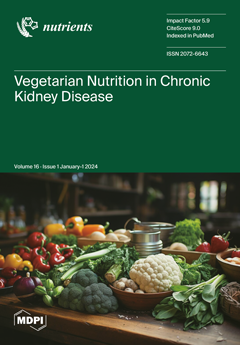This study aimed to determine the impact of various fast-interrupting shakes on markers of glycemic control including glucose, β-hydroxybutyrate (BHB), insulin, glucagon, GLP-1, and GIP. Twenty-seven sedentary adults (twelve female, fifteen male) with overweight or obesity completed this study. One condition consisted of
[...] Read more.
This study aimed to determine the impact of various fast-interrupting shakes on markers of glycemic control including glucose, β-hydroxybutyrate (BHB), insulin, glucagon, GLP-1, and GIP. Twenty-seven sedentary adults (twelve female, fifteen male) with overweight or obesity completed this study. One condition consisted of a 38-h water-only fast, and the other two conditions repeated this, but the fasts were interrupted at 24 h by either a high carbohydrate/low fat (HC/LF) shake or an isovolumetric and isocaloric low carbohydrate/high fat (LC/HF) shake. The water-only fast resulted in 135.3% more BHB compared to the HC/LF condition (
p < 0.01) and 69.6% more compared to the LC/HF condition (
p < 0.01). The LC/HF condition exhibited a 38.8% higher BHB level than the HC/LF condition (
p < 0.01). The area under the curve for glucose was 14.2% higher in the HC/LF condition than in the water condition (
p < 0.01) and 6.9% higher compared to the LC/HF condition (
p < 0.01), with the LC/HF condition yielding 7.8% more glucose than the water condition (
p < 0.01). At the 25-h mark, insulin and glucose-dependent insulinotropic polypeptide (GIP) were significantly elevated in the HC/LF condition compared to the LC/HF condition (
p < 0.01 and
p = 0.02, respectively) and compared to the water condition (
p < 0.01). Furthermore, insulin, GLP-1, and GIP were increased in the LC/HF condition compared to the water condition at 25 h (
p < 0.01,
p = 0.015, and
p < 0.01, respectively). By the 38-h time point, no differences were observed among the conditions for any of the analyzed hormones. While a LC/HF shake does not mimic a fast completely, it does preserve some of the metabolic changes including elevated BHB and glucagon, and decreased glucose and insulin compared to a HC/LF shake, implying a potential for improved metabolic health.
Full article






